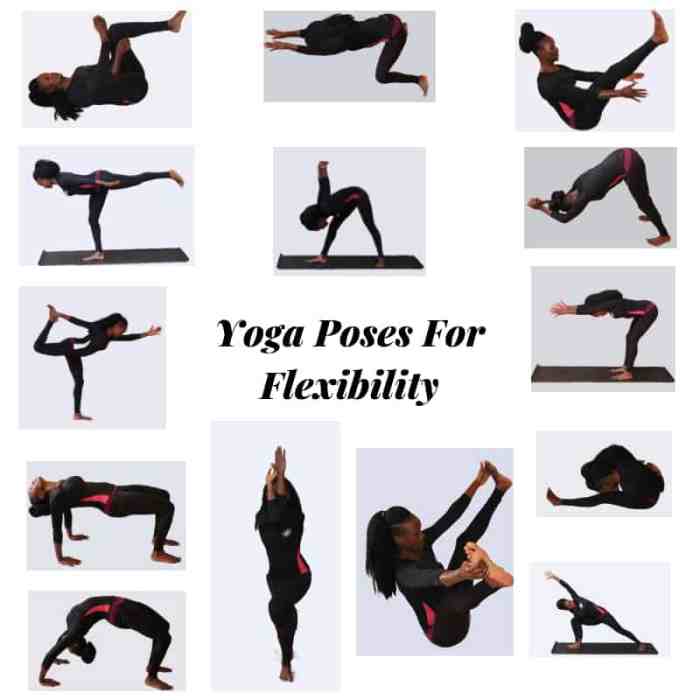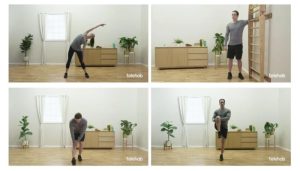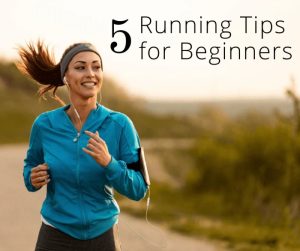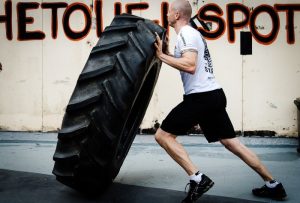
Ever wished you could touch your toes without sounding like a rusty hinge? Yearned for the graceful fluidity of a willow tree, instead of the rigidity of an oak? Then, my friend, prepare to unleash your inner yogi! This isn’t your grandma’s stretching; we’re diving headfirst (or downward-dog-first) into the world of yoga for flexibility, where ancient wisdom meets modern movement.
Get ready to bend, stretch, and maybe even giggle a little along the way.
We’ll explore the fascinating history of yoga and its surprising connection to suppleness, discover the best yoga styles for boosting your flexibility, and learn a series of poses that’ll leave you feeling limberer than a newborn kitten. From beginner-friendly stretches to more challenging sequences, we’ll tailor your journey to your unique body and its delightful quirks. We’ll even tackle the age-old question: can you really touch your toes after a lifetime of sitting?
(Spoiler alert: probably!)
Introduction to Yoga for Flexibility

Yoga, that ancient practice often depicted with serene individuals contorting themselves into pretzels, offers far more than just a calming escape. It’s a powerful tool for improving flexibility, and we’re not just talking about touching your toes (though that’s a pretty sweet bonus!). This introduction will delve into the amazing benefits of yoga for flexibility, explore the styles best suited for enhancing your bendiness, and take a quick trip through yoga’s history to see how its focus on flexibility has evolved.The benefits of incorporating yoga into your life for increased flexibility are numerous and surprisingly varied.
Improved flexibility translates to a reduced risk of injuries, both in your daily life and during physical activity. Imagine effortlessly reaching for that top shelf without groaning or twisting your back – that’s the power of increased flexibility. Furthermore, yoga’s focus on mindful movement can ease chronic pain and improve posture, leading to a more comfortable and confident you.
Beyond the physical, the mental benefits are equally significant. Increased flexibility can lead to reduced stress and anxiety, promoting a sense of calm and well-being.
Types of Yoga for Flexibility Enhancement
Several yoga styles are particularly effective for improving flexibility. Hatha yoga, with its emphasis on holding poses (asanas), provides a foundational approach to building flexibility gradually. Yin yoga, focusing on longer holds in passive poses, targets the deeper connective tissues, leading to significant increases in range of motion. Restorative yoga, utilizing props to support the body in comfortable poses, allows for deep relaxation and the gentle release of tension, improving flexibility without strenuous effort.
While other styles like Vinyasa or Ashtanga incorporate flexibility, the aforementioned three are particularly well-suited for those prioritizing flexibility gains.
A Brief History of Yoga and Flexibility
Yoga’s history stretches back thousands of years, with its origins rooted in ancient Indian traditions. While the exact origins are debated, early texts like the Yoga Sutras of Patanjali highlight the importance of physical postures (asanas) as a means to achieve physical and mental well-being. Initially, asanas were likely less about extreme flexibility and more about achieving stable and comfortable positions for meditation.
However, over time, the practice evolved, and the emphasis on flexibility became more pronounced, particularly with the development and popularization of various yoga styles in the 20th century. The evolution showcases how the practice has adapted and refined its techniques to address the needs and goals of practitioners across diverse backgrounds and fitness levels. Modern yoga’s emphasis on flexibility is a testament to its enduring adaptability and its commitment to improving overall well-being.
Yoga Poses for Flexibility
Unlocking your inner Gumby (without the clay-like texture, hopefully!) requires a dedicated yoga practice. Flexibility isn’t just about touching your toes; it’s about improving your range of motion, reducing injury risk, and feeling wonderfully limber. Think of it as preventative maintenance for your amazing human body.
Yoga Poses for Increased Flexibility
This table Artikels some key poses to get you started on your flexibility journey. Remember, consistency is key – even a few minutes a day can make a world of difference.
| Pose Name | Description | Muscles Targeted | Benefits |
|---|---|---|---|
| Downward-Facing Dog (Adho Mukha Svanasana) | Inverted V-shape, hands and feet on the floor. | Hamstrings, calves, shoulders, spine | Lengthens the spine, strengthens arms and legs, calms the nervous system. |
| Triangle Pose (Trikonasana) | Standing pose with one leg extended, torso bent towards the leg. | Hamstrings, groin, hips, spine | Improves balance, stretches legs and torso, relieves stress. |
| Forward Fold (Uttanasana) | Standing pose bending from the hips, torso towards legs. | Hamstrings, calves, hips, spine | Calming, relieves stress, stretches the back of the legs. |
| Cobra Pose (Bhujangasana) | Lying on stomach, lifting the chest off the floor. | Chest, shoulders, spine, abdomen | Strengthens back muscles, opens the chest, improves posture. |
| Child’s Pose (Balasana) | Kneeling with torso resting on thighs, forehead on the floor. | Hips, thighs, ankles | Restorative, relieves stress, stretches hips and thighs. |
| Pigeon Pose (Kapotasana) | Kneeling pose with one leg extended back, the other bent forward. | Hips, groin, thighs | Opens hips, improves hip flexibility, stretches glutes. |
| Warrior II (Virabhadrasana II) | Standing pose with legs wide apart, torso twisted. | Legs, hips, shoulders | Strengthens legs, improves balance, opens hips. |
| Seated Forward Bend (Paschimottanasana) | Seated with legs extended, torso bent forward. | Hamstrings, spine, hips | Stretches hamstrings, calms the mind, improves digestion. |
| Cat-Cow Pose (Marjaryasana to Bitilasana) | Flowing movement between arched and rounded spine positions. | Spine, abdomen, shoulders | Warms up the body, improves spinal mobility, relieves stress. |
| Low Lunge (Anjaneyasana) | Lunge position with front knee bent, back leg extended. | Hips, thighs, groin | Opens hips, strengthens legs, improves balance. |
Beginner-Friendly Yoga Poses: Proper Execution
Focusing on proper form is crucial to avoid injury and maximize benefits. Think of your body as a finely tuned instrument – treat it with respect!
Downward-Facing Dog: Begin on your hands and knees. Tuck your toes and lift your hips up and back, forming an inverted V-shape. Keep your hands shoulder-width apart and your feet hip-width apart. Lengthen your spine and press your heels towards the floor (they don’t have to touch!). Engage your core to prevent sagging in the lower back.
Imagine lengthening your tailbone away from your body.
Child’s Pose: Kneel on your mat with your knees wider than hip-width apart and your big toes touching. Sit back on your heels (as best as you can) and fold forward, resting your forehead on the mat. Extend your arms out in front of you, relaxing your shoulders and letting your chest sink towards your thighs. This pose is a gentle rest and shouldn’t cause pain.
Triangle Pose: Start standing with your feet wide apart. Turn your right foot out 90 degrees and your left foot slightly inward. Extend your arms to the sides, parallel to the floor. Bend at your hips, reaching your right hand towards your right foot (or shin) and extending your left arm towards the ceiling. Keep your torso long and avoid collapsing into your hip.
Gaze towards your left hand. Repeat on the other side.
Intermediate Yoga Poses: Progression and Modifications
These poses require more flexibility and balance. Modifications are key for beginners to build strength and flexibility gradually.
Pigeon Pose: Start on your hands and knees. Bring your right knee forward behind your right wrist, and extend your left leg back. Lower your hips towards the floor. Beginners can place a block under their hips for support. To deepen the stretch, walk your hands forward and gently press your chest towards the floor.
Remember to breathe deeply and avoid forcing the stretch.
King Pigeon Pose (Eka Pada Rajakapotasana): This is a deeper variation of Pigeon Pose. From Pigeon Pose, twist your torso to the right, bringing your right arm around to the outside of your right leg and your left arm to reach towards the sky. Beginners should focus on the basic Pigeon Pose before attempting this variation. Use blocks under your hips and chest for support.
Wheel Pose (Urdhva Dhanurasana): Lie on your back with your knees bent and feet flat on the floor. Bring your arms alongside your body, palms down. Press into your feet and hands to lift your hips and torso off the floor, arching your back. Beginners can start by lifting only their hips, or use blocks under their hands and hips for support. Keep your shoulders relaxed and away from your ears.
Creating a Yoga Routine for Flexibility
Designing your own yoga routine for flexibility is like crafting the perfect pizza – you get to choose your toppings (poses), your crust (warm-up and cool-down), and the level of deliciousness (intensity). Don’t worry, you won’t end up with a soggy bottom; with a little planning, you’ll be bending like a pretzel in no time.
Beginner Yoga Routine for Flexibility
This routine is perfect for those just starting their flexibility journey. Remember, consistency is key – even a few minutes each day is better than nothing. Think of it as a gentle awakening for your muscles, preparing them for the grand flexibility adventure ahead.
Warm-up (5 minutes): Begin with some gentle neck rolls, shoulder rotations, and arm circles. Then, perform cat-cow poses (Marjaryasana to Bitilasana) for five repetitions to loosen up the spine. Finish with some simple leg swings and hip circles. Imagine your body is a rusty hinge; we’re just oiling it up before the main event.
Poses (15 minutes): Hold each pose for 30 seconds, focusing on your breath and gently increasing the stretch as you feel comfortable. Include:
- Downward-Facing Dog (Adho Mukha Svanasana): Lengthens the hamstrings, calves, and shoulders. Imagine you’re a happy puppy stretching out in the sun.
- Forward Fold (Uttanasana): Stretches the hamstrings and calves. Feel the gentle pull, but don’t force it – think of it as a friendly conversation with your hamstrings, not a wrestling match.
- Triangle Pose (Trikonasana): Stretches the hips, groin, and hamstrings. This pose helps you reach for the horizon, both literally and figuratively.
- Pigeon Pose (Kapotasana): Opens the hips and improves hip mobility. This one might feel a bit intense at first, so listen to your body and back off if needed. Think of it as a gentle hip hug.
- Child’s Pose (Balasana): A restful pose that stretches the hips, thighs, and ankles. It’s your moment of zen amidst the stretching spree.
Cool-down (5 minutes): End with Savasana (Corpse Pose) for at least 5 minutes, allowing your body to fully relax and integrate the stretches. Let your body sink into the mat like a melting marshmallow.
Intermediate Yoga Routine for Flexibility
Ready to take your flexibility to the next level? This routine increases the intensity and duration of the poses, challenging your body to deepen its range of motion. It’s like leveling up in a video game; you’ve earned the right to tackle tougher challenges.
Warm-up (10 minutes): Include sun salutations (Surya Namaskar) for five rounds to increase heart rate and warm up major muscle groups. Follow this with dynamic stretches like leg swings, torso twists, and arm circles. Think of it as a pre-game warm-up for your muscles.
Poses (30 minutes): Hold each pose for 60 seconds, focusing on your breath and deepening the stretch. Include all the beginner poses but hold them longer. Add more challenging poses such as:
- King Pigeon Pose (Eka Pada Rajakapotasana): A deeper hip opener than Pigeon Pose. It’s like giving your hips a luxurious spa treatment.
- Splits (Upavistha Konasana): A classic flexibility pose that requires dedication and practice. Don’t be discouraged if you can’t get all the way down; even a small improvement is a victory.
- Standing Splits (Hanumanasana): An even more advanced pose. Remember to listen to your body and avoid pushing yourself too hard.
Cool-down (10 minutes): Include longer Savasana (Corpse Pose) and gentle stretches like seated forward bends and twists. This is the time for your body to recover and consolidate its gains.
Adapting a Yoga Routine for Flexibility to Individual Needs
Flexibility is personal; what works for one person might not work for another. Listen to your body, respect your limitations, and modify poses as needed. It’s a journey, not a race.
Modifications: Use props like blocks, straps, and blankets to support your body and make poses more accessible. For example, if you can’t reach your toes in a forward fold, use a block to shorten the distance. If you have tight hamstrings, keep your knees slightly bent. If a pose causes pain, stop immediately and try a different variation.
Limitations: If you have any injuries or medical conditions, consult with a doctor or physical therapist before starting a yoga routine. They can help you identify poses that are safe and effective for your body. Remember, safety first!
Understanding Your Body’s Limitations
Yoga is all about connection – connecting with your breath, connecting with your body, and connecting with your inner peace. But sometimes, that connection reveals limitations, and that’s perfectly okay! Ignoring your body’s signals is a recipe for injury, not flexibility. This section is about respecting your body’s wisdom and working
with* it, not against it.
Understanding your body’s limitations isn’t about accepting defeat; it’s about smart progress. Think of it like climbing a mountain: you wouldn’t try to scale Everest on your first hike, would you? You’d start with smaller hills, building strength and endurance. Similarly, building flexibility requires patience, consistency, and a healthy dose of self-awareness. Pushing too hard too soon can lead to setbacks, while a mindful approach leads to sustainable progress and a happier, healthier you.
Modifying Poses for Injuries and Limitations
Modifying poses is crucial for practicing yoga safely and effectively, regardless of your experience level or physical condition. It allows everyone to participate and reap the benefits of yoga, adapting the practice to individual needs and capabilities. For example, if you have knee problems, you might modify a low lunge by placing a blanket or bolster under your knee for support.
Similarly, if you have tight hamstrings, you could bend your knees slightly in a forward fold to avoid overstretching. Remember, the goal is to feel a gentle stretch, not pain.
The Role of Proper Breathing in Flexibility and Injury Prevention
Proper breathing, or pranayama, is the unsung hero of flexibility. It’s not just about getting enough oxygen; it’s about using your breath to deepen your stretches and relax your muscles. Deep, controlled inhales can help you lengthen your spine and expand your chest, while slow exhales allow you to release tension and deepen into poses. For example, in a forward fold, inhaling can help you lengthen your spine, while exhaling allows you to gently fold deeper into the pose.
Incorporating conscious breathing throughout your practice helps to prevent injury by ensuring your muscles are relaxed and your movements are controlled. Ignoring your breath is like trying to drive a car without steering – you might get somewhere, but the journey will be bumpy, and you might crash!
Yoga and Overall Health & Fitness
Yoga, with its emphasis on flexibility, is more than just a trendy workout; it’s a holistic approach to well-being that profoundly impacts your overall physical and mental health. Think of it as a full-body tune-up, lubricating your joints, strengthening your muscles, and calming your mind – all at once! The connection between flexibility, achieved through yoga, and overall fitness is undeniable, leading to a healthier, happier you.Improved flexibility, a cornerstone of a yoga practice, isn’t just about touching your toes (though that’s a nice bonus!).
It significantly enhances your physical performance in various ways, creating a ripple effect of positive changes throughout your body.
Flexibility’s Impact on Physical Activities
Enhanced flexibility directly translates to better performance in other physical activities. Imagine a runner with tight hamstrings – their stride will be restricted, increasing their risk of injury. Conversely, a flexible runner enjoys a more efficient, powerful stride, reducing strain and improving speed and endurance. Similarly, increased flexibility in the shoulders and back benefits swimmers, allowing for a wider range of motion and more powerful strokes.
Even everyday activities like lifting groceries or playing with your kids become easier and less prone to injury with improved flexibility. Think of it as upgrading your body’s operating system – smoother, more efficient, and less prone to crashes (aka injuries).
Comparing Yoga to Other Flexibility Exercises
While other flexibility-enhancing exercises like stretching or Pilates offer benefits, yoga distinguishes itself through its holistic approach. Yoga combines stretching with strength training, balance work, and mindfulness techniques. This multi-faceted approach makes it particularly effective in improving overall flexibility and body awareness. While static stretching (holding a stretch for a period) is common in other disciplines, yoga incorporates dynamic stretches (moving through a range of motion) and isometric holds (contracting muscles against resistance), offering a more comprehensive approach to flexibility development.
Pilates, for instance, focuses more on core strength and stabilization, while yoga incorporates core work but extends to a wider range of movement and poses.
The Importance of a Balanced Fitness Routine
A truly well-rounded fitness routine isn’t just about one aspect; it’s about the harmonious blend of cardiovascular exercise, strength training, and flexibility work. Think of it as building a house: you need a strong foundation (strength training), the plumbing and electrical (cardiovascular health), and the finishing touches (flexibility) to create a beautiful, functional home (your healthy body). Cardiovascular exercise improves your heart health and endurance, strength training builds muscle mass and bone density, and flexibility work, like yoga, enhances range of motion, prevents injuries, and promotes overall well-being.
Ignoring any one of these elements compromises the overall strength and resilience of your body. For example, a marathon runner who neglects strength training and flexibility is at higher risk of injury, while a weightlifter who neglects cardiovascular health and flexibility may struggle with stamina and mobility. A balanced approach is key to optimal health and fitness.
Visual Aids for Yoga Poses
Let’s face it, yoga instruction manuals aren’t exactly known for their thrilling visuals. Often, they look like someone tried to capture a contortionist mid-seizure. But fear not, aspiring yogis! With a little imagination and some clear descriptions, even the most challenging poses become achievable. We’ll dissect the visual elements of a few key poses, focusing on alignment and the delightful dance of muscle engagement.
Downward-Facing Dog: A Visual Guide to Canine Coolness
Downward-facing dog (Adho Mukha Svanasana) is a cornerstone pose. Imagine a slightly inverted V-shape, with your hands shoulder-width apart and your feet hip-width apart. Your body should form a straight line from head to heels, although beginners might find their hips a bit higher. The key is to lengthen your spine, engaging your core muscles to prevent sagging in the lower back.
Your shoulders should be relaxed away from your ears, and your heels should strive towards the mat, even if they don’t quite reach it. Visualize the muscles in your legs, arms, and back working in harmony to create this elegant posture. The hamstrings and calves are particularly engaged, while the shoulders are working to stabilize and prevent rounding.
Warrior II: A Posture of Power and Presence
Warrior II (Virabhadrasana II) is all about strength and stability. Picture a wide stance, with your front foot pointing forward and your back foot turned out at a 90-degree angle. Your front knee is bent at a 90-degree angle, directly over your ankle. Your arms are extended parallel to the floor, creating a sense of expansiveness. Imagine your legs are firmly rooted to the earth, like the legs of a mighty warrior.
The muscles of your legs, especially the quads and glutes in your front leg, are actively engaged. Your core is engaged to maintain balance and prevent twisting. Visualize a feeling of grounding and strength emanating from your feet. Your gaze should be steady, over your front hand, instilling a sense of calm focus.
Triangle Pose: A Balancing Act of Beauty and Grace
Triangle Pose (Trikonasana) looks deceptively simple, but achieving perfect alignment requires attention to detail. Imagine a wide stance, with your feet approximately three feet apart. Turn your right foot out 90 degrees and your left foot slightly inward. Extend your arms parallel to the floor and bend at your right hip, reaching your right hand towards your ankle (or shin).
Your left arm extends towards the ceiling. Your torso should be elongated, not collapsed. Your hips should be square, preventing them from twisting. Visualize a straight line running from your extended arm, down your side body, and through your legs. The muscles in your legs, particularly the inner thighs and hamstrings, are engaged to support the stretch.
The side body muscles are engaged to prevent collapsing. The stretch should be felt along the sides of your body, a gentle lengthening rather than a forceful pull.
Tree Pose: Finding Balance and Inner Peace – A Detailed Description
The Tree Pose (Vrksasana) is a beautiful example of a pose that provides both physical and mental benefits. Imagine standing on one leg, with your other foot pressed against your inner thigh or calf. Your hands are pressed together in a prayer position, or you can extend your arms towards the sky. Your eyes are closed or focused on a single point.
The physical benefits are obvious: improved balance, strengthened legs and core, and increased flexibility in the hips. However, the mental benefits are equally profound. The act of balancing requires focus and concentration, quieting the mind and promoting a sense of calm. This posture encourages self-awareness, as you become acutely aware of your body’s position and the subtle shifts in your balance.
The stillness required fosters a sense of inner peace and tranquility, making it a perfect pose for grounding and centering. The engaged muscles include the leg supporting the weight, the core for stability, and the muscles of the standing leg to maintain the posture.
A Flowing Sequence: Sun Salutation Variations
Let’s envision a sequence of three poses: Mountain Pose (Tadasana), Forward Bend (Uttanasana), and Plank Pose (Phalakasana). We start with Mountain Pose, standing tall, grounding through our feet. The transition to Forward Bend is smooth, hinging at the hips and allowing the torso to gracefully fold towards the legs. The weight is distributed evenly through the feet, and the head hangs heavy.
From the Forward Bend, we step or jump back into Plank Pose, engaging the core and maintaining a straight line from head to heels. This sequence, a simplified version of a Sun Salutation, promotes strength, flexibility, and a sense of flowing movement. It allows for a mindful transition between poses, emphasizing body awareness and controlled breath.
Last Recap

So, there you have it – a journey into the wonderfully bendy world of yoga for flexibility. Remember, the path to increased flexibility is a marathon, not a sprint. Listen to your body, celebrate small victories (like finally touching your toes!), and embrace the process. Whether you’re a seasoned yogi or a complete newbie, the rewards – both physical and mental – are well worth the effort.
Now go forth, and bend like a pretzel (safely, of course!).
Question Bank
How often should I practice yoga for flexibility?
Aim for at least 2-3 times a week for optimal results. Consistency is key!
What if I have a back injury? Can I still do yoga?
Absolutely! Many poses can be modified to accommodate back injuries. Consult a doctor or physical therapist before starting any new exercise program, and always listen to your body.
Do I need any special equipment for yoga?
A yoga mat is recommended for comfort and grip, but not strictly necessary for beginners.
How long does it take to see results from yoga for flexibility?
It varies from person to person, but you should start noticing improvements in flexibility within a few weeks of regular practice.





